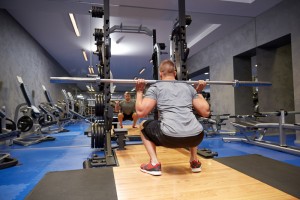Are You Squatting Correctly?
Exercise
Posted on September 29, 2015 by Jenny Cromack
Odds are if you’re a PT client or a gym member at one of our Leeds Personal Training Studios or if you exercise on a regular basis, you’ve completed squats. Squats are a fundamental exercise that everyone should have in their exercise armoury. The squat has huge potential to develop strength, speed, acceleration, endurance and even flexibility. Unfortunately the movement is often completed poorly, limiting its effectiveness and potentially leading to shorten ranges of motions and muscle imbalances. Follow this problem solving blog to help improve your back squat and make sure you are squatting correctly.
Before we begin to look at whether you are squatting correctly it is important to note that not every solution will be the right one for you, so have a play around and if you have any questions ask one of the personal trainers. Here are the top 5 squatting errors:
Common Issue 1. Poor Depth – Your Hips Should Travel Below The Line of Your Knees
- Take the feet out wider than the shoulders and play around with depth at different foot positions
- If you’re getting stuck in the bottom position then reduce the load
- Improve your hamstring flexibility and strength, flexibility should be developed first however.
- Improve your adductor flexibility.
- Check your ankles range of motion, it may be that you have tight calves. To do this place your toes against the wall, with your heel remaining on the floor can you touch the wall with your knee, by driving it over the toe?
- Turn out your feet so that the toes point at around 10 to 2, this will help reduce internal rotation of the foot causing your heel to lift.
- Reduce load immediately, the bar or weight is presently too heavy for your trunk strength
- Build back strength involving exercises that have an isometric component in the shortened position, rack pulls, one arm rows with pauses, and overhead pressing can all be beneficial for this.
- Focus on maintaining a tall chest during the squat, this can be achieved by focusing on keeping your elbows under the barbell
- It is likely you have weak abductors and need to incorporate more glute work into your training.
- Single leg exercise should also be incorporated in greater quantity to help with proprioception and motor skill development
- Excellent glute exercise to include would be a resisted bridge, the Romanian deadlift, and resisted clams using a band.
- Once again this is a common issue in squats that are too heavily loaded, so reduce the load first.
- Another common issue with this fault is weak hip extensors, once again you need to then return to more glute work


